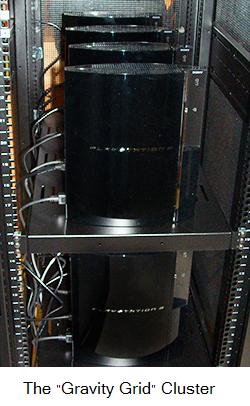The seventh generation of the video game console wars has been rough on Sony’s Playstation division. Nintendo’s Wii has dominated and the XBox 360 now has a Halo title.
The Playstation 3 is a machine ahead of its time. Sony felt obliged to include components that essentially priced the console out of the reach of the Playstation market. But during development Sony did a remarkable thing that may yet save the Playstation 3. Sony made it an open platform. You can install Linux on it and use it as a general purpose computer.
It has a general purpose processor, as well as eight additional processing cores, each of which has two processing pipelines and can process multiple numbers, all at the same time.
I’ve written before about how the Playstation 3 – and its components – have been used for research purposes. But what would it cost to replace research supercomputers with Playstations?

[Astrophysicist Dr. Gaurav Khanna once] relied on grants from the National Science Foundation (NSF) to use various supercomputing sites spread across the United States “Typically I’d use a couple hundred processors — going up to 500 — to do these same types of things.”However, each of those supercomputer runs cost Khanna as much as $5,000 in grant money. Eight 60 GB PS3s would cost just $3,200, by contrast…
Khanna says that his [Playstation 3 cluster - "Gravity Grid" - ] has been up and running for a little over a month now and that, crudely speaking, his eight consoles are equal to about 200 of the supercomputing nodes he used to rely on.
“Basically, it’s almost like a replacement,” he says. “I don’t have to use that supercomputer anymore, which is a good thing.”
“For the same amount of money — well, I didn’t pay for it, but even if you look into the amount of funding that would go into buying something like eight PS3s — for the same amount of money I can do these runs indefinitely.”
Neither Khanna nor the National Science Foundation paid for the system. Sony covered the cost… this time.
But let’s say a university had to cover the cost for itself. Assume that the Playstations cost $3,200 and setup cost another $5000. That comes to a cost of about $41 per supercomputer node ($8200 / 200 nodes) – to own.
Before the Gravity Grid, Khanna had been renting computer time for $10 a node per run ($5000 / 500 nodes).
So, four runs after buying the cluster a university could break even. In fact, the cluster could become a profit center if they rented time to other universities.
Why isn’t the NSF doing this everywhere?